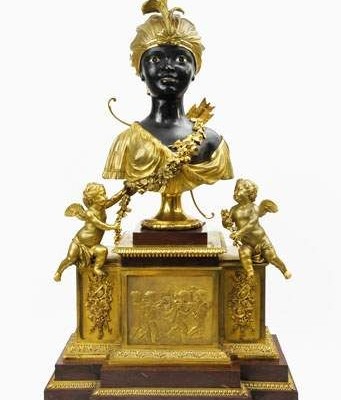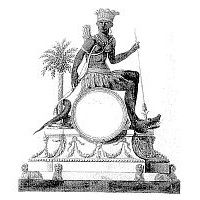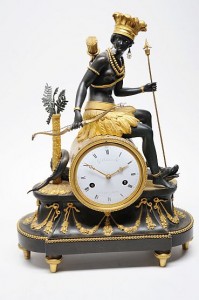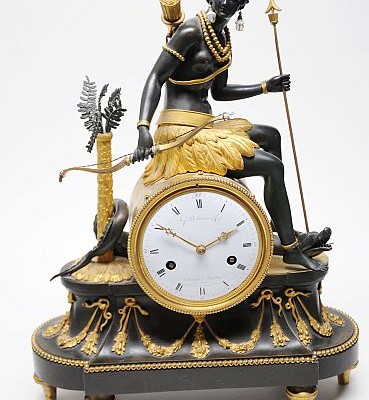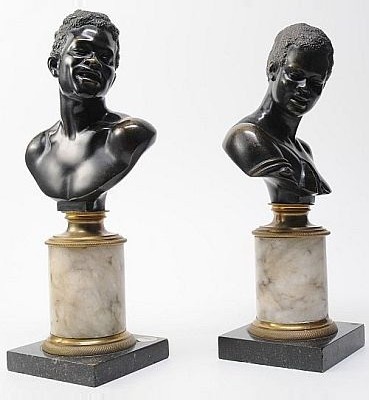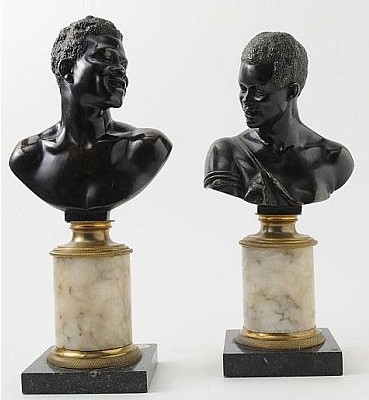Jean-Simon De Verberie and the Pendules au Nègre
by Harm Botje
In 1784 the two Horlogiers du Roi, Furet en Godon, offered to queen Marie-Antoinette a very special clock.
Négresse enrubannée, akin to the pendule of Marie-Antoinette.
La Négresse enrubannée, as the pendule was named, was mounted on a music box that could play 64 different tunes. When pulling the earrings of the Négresse, her eyes showed the time. Her price: 4000 livres, about a quarter of a million euros, at a time when 300 livres was considered to be a good yearly income. Four of these pendules were made. One of them can be found in Buckingham Palace. It was bought around 1790 by the Prince-Regent. They were the first examples of what in the years after would become a precious and fashionable article, the Pendules au Nègre, also called Pendules au Bon Sauvage, after the idea Jean-Jacques Rousseau had popularised.
All the pendules, statues and chandeliers on this page are designed, made or inspired by the undoubted master in the field, Jean-Simon De Verberie (1764-1824). The statues and the candlesticks were also made in his atelier. Some even call De Verberie the Michelangelo of the genre. He was twenty years old and a promising clockmaker when Marie-Antoinette played the 64 airs on her Négresse. He witnessed her decapitation and Robespierre’s Reign of Terror and around 1800 he opened shop in the Rue de Barbette in the Parisian Marais. In this quarter of the city he remained all his working life, from 1804 onwards on the Boulevard du Temple and from 1812-1820 in the Rue des Fossés du Temple, where he ran a large atelier.
The way he spelled his name is a sign of the turbulent times he lived in.
After the Revolution, he dropped the aristocratic prefix “de” and called himself Verbery. Then he combined name and prefix into Deverberie, to end his life aristocratically again as De Verberie. On the 23rd of Nivôse of the year VII (January 12, 1799) he officially registered a “baker’s dozen” of his designs, later followed by others. They can be admired at the Bibliothèque Nationale in Paris. Amongst them was the design of “our” Amérique, the pendule top left. Many leading clock museums possess De Verberie’s work, among them the Musée François-Duesberg in Mons, Belgium. His pendules all have one thing in common. They stand out by their very detailed and refined finishing. De Verberie’s pendules are never varnished, they are patinated. The eyes are out of enamel, never painted or made of gass. The earrings with which he adorned his female figures are made of finely cut crystal of a perfect colour. More than any of his competitors, and he had many, De Verberie excels in his finishing touch. He is the master of the détail.
Sketch of ‘Amérique’, deposited by De Verberie. It is the upper-left pendule of the Zuylenburgh Collection.
click to enlarge/minimise
“Politi Pecalndules”
But De Verberie not only made very special pendules that are remarkable by their refinement. In a certain way his pendules are also social and political statements. They are a turn against slavery and symbolise equality. De Verberie got the ideas for his designs partly from a book that had an enormous impact in late 18th century France. The book, Paul et Virginie, is probably one of the most popular works in French litterature. It was written by Jacques-Henri Bernardin de Saint-Pierre (1737-1814) and was originally published 1787 as part of his “Études de la nature”. Based on Rousseau’s ideas Bernardin de St. Pierre elaborated on his experiences and impressions during his trip around Africa to Île de France, present day Mauritius and at that time a French slaveholding colony. In 1789, the year the French Revolution broke out,
Paul et Virginie was published as an independent novel, in Paris by L’Imprimerie de Monsieur. That publishing house was owned by his father-in-law Pierre-François Didot (1731-1795), member of a famous publishing dynasty. After that, the reprints and adaptations followed each other in quick succession.

